People thought I was crazy in 2008 when I predicted the collapse of Fannie Mae, Freddie Mac, and General Motors.
People thought I was crazy in late 2008 when I said the biggest mall owner in America and one of the biggest newspapers would go bust.
People thought I was crazy when I said we’d see riots in the streets after the financial crisis… then the Occupy Wall Street movement erupted.
People thought I was crazy in 2012 when I predicted oil prices would go from over $100 a barrel to less than $40.
I simply go where the data takes me. And when it leads me to a conclusion that perhaps seems “crazy” on the surface, I don’t disregard it out of hand. I put my biases to the side and trust my analysis.
And that’s what happened last year when I warned that Boeing – one of America’s most storied companies – was going to collapse… then, a few months later, their planes started to fall apart mid-flight.
While the Boeing story is only in its first inning – with a number of Congressional and regulatory investigations underway – when the dust settles, the collapse of this iconic American company could go down as one of my Hall of Fame predictions.
When it comes to the Hall of Fame though, nobody has more points on the board than Dave Lashmet.
At the same time I was investigating Boeing, Dave was investigating another aero-company. He wasn’t seeing problems though. He was doing what he does best, seeing untapped opportunity.
While everyone knows Boeing, you’ve likely never heard of Bombardier, a jet manufacturer based in Montreal, Canada.
In late 2022, Dave wrote that Bombardier was poised to become a major supplier to the U.S. military, writing:
“And if there’s one lesson in the 100-year history of military aviation, it’s that owning the sky wins the ground. That’s why all the free world’s militaries and top military contractors are looking to Bombardier. It builds the jets with this technology.”
Since then, Bombardier’s stock is up 177% (at the time of writing) and continues to go from strong to stronger.
In this week’s Spotlight, we want to look forward. That’s why we won’t be analyzing Bombardier or Boeing, but a third aero-company that Dave Lashmet recently recommended to his readers.
As an exclusive membership perk of Porter & Co., Dave’s full analysis is below – and if you missed our previous Spotlight’s on Dave’s research, you can click to read Issue #1 and Issue #2.
Editor’s Note: Dave also recently published a new report for us – it details what his team calls a “radically misunderstood discovery that could eclipse AI and deliver significant gains.”
To read Dave’s new report go here now.
The first helicopter gunship slid in on my right…
I could see it hovering there like it was hunting. It was as big as a bus, without any visible means of support. Its whirring blades were too fast to see.
Moments later, another helicopter loomed in on my left.
Normally, seeing two Apache gunships would be grounds for pause… They hit what they aim at, day or night.
But these pilots were “flying blind” as part of a training mission for zero-visibility landings. And I was on a research mission to learn everything I could about the U.S. Army’s next-generation rotorcraft.
That’s why I traveled to the middle of nowhere last month…
Fort Novosel sits across 65,000 acres in a rural corner of Alabama known as “wiregrass country.” Here’s what the base’s “flight line” looks like from the outside. Anyone trying to cross the fence is met by deadly force.

Security is tight because Fort Novosel houses the Army’s newest aircraft.
You see, every five years, Army aircraft are practically rebuilt from the inside out.
If you start from scratch, a newly built aircraft is around $100 million, including spare engines. But the list price for a basic model is more like $75 million. And these aircraft have all the latest computer chips, plus advances in radar and stealth.
Seriously. The latest Echo version of the Apache gunship helicopter has new longer-range night-vision sensors. It’s also quieter than previous Apache helicopters, with new composite blades and stronger, more fuel-efficient twin engines each with 3,000 horsepower.
The Apache Echo is also all-weather: including dust storms, snow, or fog. That’s not just for takeoffs and landings. It can even hide in foul weather – essentially making it invisible.
But what makes an Apache special is that both its front gunner and rear pilot have their own optics.
Normally, the gunner runs a targeting laser, plus a magnified thermal night sight. Meanwhile, the pilot sitting directly behind the gunner has a wider field of view, plus radar. It’s not simple to land this way because the camera that the pilot is using is 4 feet below him and 12 feet forward.
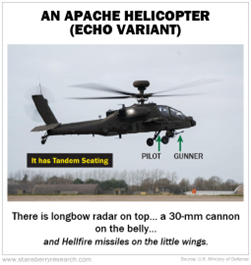
Plus, because it’s a “gunship,” there’s a 30-millimeter cannon in the belly of the helicopter. The exact sensor suite is classified, but let’s just say, pilots can see for miles in the dark.
The helicopter also carries Hellfire missiles. Technically, these missiles are “Heliborne, Laser, Fire and Forget” missiles. But everyone calls them Hellfires because that’s what they bring.
One version of these missiles has a 20-pound high-explosive shaped charge that can pierce a tank’s armor. Another version spreads a cloud of metal fragments at high speeds from miles away. There’s also one with six titanium sword blades to cut apart a lone terrorist instead of destroying an entire village.
Within two years, Apaches will also use drones to find targets and fire from over the horizon. Meanwhile, they’ll have a better electronic warfare kit to defeat enemy missiles or drones.
But the Apache isn’t the Army’s only next-generation aircraft…
This month, we’re taking a look at the Army’s future “tiltrotor” aircraft… and we’re recommending a military contractor with a 50-year history in controlling flight. We think 100% gains are possible.
So let’s get started…
The Next-Generation Tiltrotors
Tiltrotors are an old idea. Henry Berliner flew the first one in 1923, on top of a painted cloth biplane. The idea is to have two engines with propellers spinning in opposite directions to balance torque (which means, its twisting force).
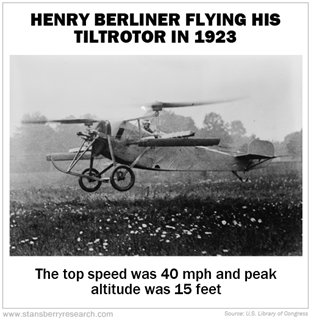
Thanks to their unique design, tiltrotors can take off and land like helicopters, but then their propellers tilt forward, so that they can fly as fast as fixed-wing airplanes.
Henry Berliner’s first tiltrotor flew at a wind-aided 40 mph. But new tiltrotor aircraft fly at 350 mph true airspeed. So the speed of a tiltrotor has jumped by a factor of 10 over the past 100 years.
The first U.S. government experiments with tiltrotors flew in the 1950s with Bell Helicopter’s Bell XV-3. That was followed by the XV-15, a smaller version of today’s V-22 Osprey.
However, like you may have seen in the news, every V-22 Osprey tiltrotor is currently grounded after one crashed off the coast of Japan. Early indications are that this is a problem with the aircraft’s power-sharing transmission.
You see, military airplanes fly into combat zones. Ground fire is a problem. There’s also a problem with birds since these aircraft fly at treetop height. So there’s a risk that a tiltrotor aircraft loses one of its two engines.
Ospreys have two engines, one per wingtip – with the propellors spinning in opposite directions. But if one engine fails, there’s no lift on that side of the aircraft. So it spins – and falls.
To control for this, there’s an axel inside the wing so one engine can spin both propellers. This gearing is also how four-wheel drive vehicles work. The trouble happens because in the Osprey, each engine tilts 90 degrees – so the transmission twists too.
Tilting the engine was Bell’s way to beat out Boeing (BA) for a tiltrotor design in the 1970s. Boeing’s original design spun the propellers straight up (to hover) or forward (to fly). But at the time, Boeing hadn’t worked out the gearing for the stresses of speed and gravity. So Bell’s design for the XV-15 – with a solid drive shaft to the propellers – won the NASA contract. And that’s what evolved into the V-22 Osprey.
And there’s a second problem…
So that Ospreys can be stored in ships, their wings can fold. That means every wire, hydraulic line, and fuel line to an engine has to spin and fold. That’s a double point of failure.
All these connections can be fixed. But the transmission issue doesn’t have a solution yet. So Bell is making a new tiltrotor aircraft for the U.S. Army, the V-280 Valor:
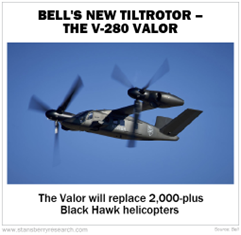
The Valor is revolutionary for its speed, range, and design – which leans on Boeing’s original plan. In the Valor, only the propellers tilt. So it’s simpler to put the engine in the wing. Plus, the wings on the Valor don’t fold for storage. That’s another layer of complexity gone. Instead, the Valor is smaller, so it fits inside a carrier or an amphibious landing ship.
That means a Valor can’t carry a light-duty truck or a platoon of troops like an Osprey. But a Valor can carry 12 troops for up to 750 miles, bring them in at 350 mph, land them, and then return. This is double the speed and triple the combat radius of the Black Hawk helicopters it’s replacing.
The Osprey only had one opening for self-defense: a tailgate. In the Valor, there are two side doors – and two door gunners – in addition to the 12 troops. There are also plans to fit Valors with a forward-firing cannon… or even Hellfires. So the Valor will have a 360-degree field of fire to protect troops for opposed landings. The Valor also has a V-shaped tail that door gunners can shoot past. The new tail is also aerodynamic: the propeller wash doesn’t buffet it. This reduces vibrations so it allows higher speeds.
Each new Valor costs $50 million-plus. And the Army will need thousands of them. That’s great news for Bell… and the other 25 companies that contribute key systems.
That’s where this month’s recommendation comes in… Put simply, it’s the reason the Valor’s tiltrotors actually tilt.
Moog Controls How Things Fly
Moog (NYSE: MOGA) is a U.S.-based maker of precision aircraft and spacecraft parts – plus air pumps. It builds hydraulic or electric control arms for elite aircraft: everything from Apache helicopter gunships to F-35 fighter jets.
The firm has designed aircraft parts for decades. For example, Moog controllers drive the rudders and elevators in the Airbus A350-900. This matters because of how large these surfaces are, and how fast an Airbus A350 jet goes.
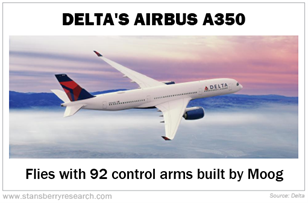
Let me explain…
In mechanical engineering, force is measured in newtons. Each newton is a kilogram times meter per second per second (that’s squared). So a 7-pound bowling ball falling at 32 feet per second squared generates 30 newtons.
An Airbus A350 (like Delta flies) weighs 500,000 pounds. It goes 600 mph. So its control surfaces – a tail rudder or aileron (a hinged flight control surface) in the wing – experience 250,000 newtons.
But when you build any aircraft, you over-engineer it. So Moog’s control arms can meet or exceed 600,000 newtons – which equals the force of 20,000 falling bowling balls.
The industry term for Moog’s control arms is “actuators,” and they come in different flavors. They can be hydraulic, pneumatic (air-powered), or entirely electromechanical. The common theme of all these devices – besides the control logic – is what they control.
In essence, Moog is the world’s best fluid-dynamics engineering firm because air is a low-density fluid. But it’s also turbulent, and it builds vortexes (tornadoes). Meanwhile, aircraft move through the air so quickly that they slip through it like a boat in a fluid. That’s why it’s fluid dynamics.
Likewise, designing pumps that push hydraulic fluid to drive a control arm uses fluid dynamics:
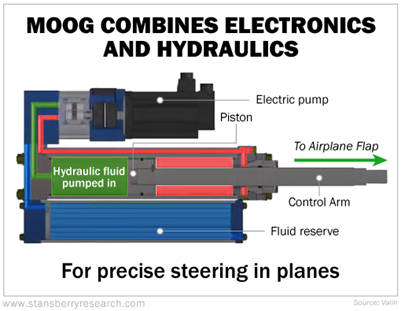
This is just a schematic diagram. It’s not in 3D, and we didn’t list the materials. Still, you get the point: making super-strong, precision devices for aerospace applications is difficult.
And tiltrotors are a weird case with three unique instabilities that require precise control.
First, tiltrotors can’t take off like a normal airplane because their propellers are too long. They act like helicopter rotors to support the plane and any “sling loaded” cargo. So tiltrotors take off vertically like a helicopter, then the engines tilt to move forward.
The wing on a fixed-wing aircraft needs forward speed or it falls. So there’s a fixed rate just above stall speed as the propellors turn from straight up to forward. Ideally, that’s 7 degrees per second. That’s for perfect weather and when you’re not getting shot at.
In practice, this range is between 3 degrees and 9 degrees per second. So controlling the tilt of the engines is a must-not-fail system. Moog builds the control arms for both engines on the V-280 Valor using the company’s smart hydraulics.
Second, a tiltrotor’s value is in its range and speed, so the landing gear retracts to cut drag. But the landing gear has to fully extend when you land to act as a shock absorber. That’s another Moog part. And it always has to work or else your aircraft comes apart and your mission fails. That’s why Moog was chosen by Bell as a supplier. Its controllers work.
Finally, the Valor has a V-shaped tail, and the movable edge is both an elevator and a rudder. These “ruddervators” control the plane’s direction of travel – sometimes even without input from the pilot. You see, autopilot can fly the aircraft to free up a military pilot’s attention to solve mission-critical tasks. For example, the pilot may look down at a convoy the plane is shadowing as “overwatch.” Search and rescue also demand the pilot’s attention: like hovering over a life raft in the ocean in a cross-breeze. So autopilot ends up flying a lot of the time. Two more Moog parts precisely control these ruddervators.
We keep stressing the idea of control because Moog parts are a mix of a “muscle” and a “brain.” Each of Moog’s parts is guided by field-programmable gate arrays (“FPGAs”). An FPGA is a blank logic chip that you program to do specific tasks. And today’s FPGAs are nearly as fast as the logic chips in smartphones.
That’s because the company keeps inventing…
453 Patents and Counting
Over the past three years, Moog has spent more than $100 million per year on research. That has produced a steady stream of U.S. patents – now totaling 453. Each patent gives Moog commercial exclusivity for its inventions built into products.
Unfortunately, patents don’t stop military rivals: China and Russia can steal Moog’s plans. So writing patents is a balancing act of explaining your invention and keeping your trade secrets hidden. But a patent’s claims cover broadly similar ideas. So the final patented device comes from hundreds of possible ideas in the patent.
For example, let’s look at Moog’s newest patent, which was just issued last week. It’s for a “rotary-wing aircraft individual rotor blade pitch control system,” invented by John Kopp at Moog.
The patent details using four actuators for a four-bladed helicopter to vary the angle of each blade. But Kopp doesn’t explain why you would do this – just that it should work. Here’s his illustration:
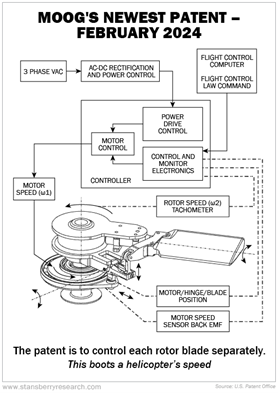
So it’s a mix of mechanical devices and lots of sensors and control codes. We could call it a “contraption” – but it’s actually an elegant solution to a major problem for rotorcraft.
See, a hovering helicopter gets equal lift from both sides of its rotor – its spinning wing. But as a helicopter picks up speed, there’s more wind for each blade moving forward. And there is less wind as each blade circles backward – eventually stalling.
This stall starts at the 9 o’clock tip position, then heads inward. Then the helicopter dips. There’s also a shuttering – first in one rotor, then all – after which, everything shakes. It’s especially bad for the blades, which can break. So this stall limits a helicopter’s forward speed.
But if you can change the angle of the blades as they rotate, you might get more speed. You see, although the tip of a blade moves quickly, the hub only spins 500 revolutions per minute. So the rotor blades are spinning less than 10 times per second at the hub. Kopp’s invention can change the blades’ angles within a single rotation and for every rotation.
I’m not certain if this would work in a simulation or a wind tunnel – let alone in flight. However, Kopp’s patent admits it might be applied to drones or tiltrotors, not helicopters. And Moog’s legal team liked the idea enough to patent it.
So whether or not this idea will see the light of day is anyone’s guess. Moog keeps some of its best ideas hidden. We know this because Moog’s reported research spending fell over the past three years. Yet, its management team says that’s because Moog is involved in secret projects.
For financial reporting purposes, this is listed as revenue from a government customer. But there’s no way to know what it’s for. It could be for the Valor, the Air Force’s next-generation air dominance fighter (“NGAD”), or something else up in space. Either way, it means that Moog is winning research contracts to boost future sales.
Why We’re Recommending Another Military Contractor
It’s no coincidence that I started this issue with my trip to Fort Novosel.
Although I can’t detail everything I learned, I can give you the gist…
The Army is carefully tracking events in Ukraine and learning what does or doesn’t work in battle. For example, Russian helicopters can kill European tanks at night at stand-off range. But Russia’s helicopters were driven out of the combat zone using longer-range missiles tipped with cluster bombs.
So for combat against near-peer enemies, you need fortified helicopter bases away from the front lines. Otherwise, they’re exposed to airborne attacks. That’s why tiltrotors are the future for U.S. Army aviation. They offer extended range and speed.
And Russia isn’t the only threat out there. China’s threat to free trade in the Pacific Ocean. China is demanding Japanese freighters and U.S. warships surrender the South China Sea. China is also testing the defenses of Taiwan daily, and it seized some Philippine islands. So the U.S. Army is making defensive plans within Asia.
But you don’t have to take my word for it…
General Charles Flynn runs Army Pacific command. He’s a master parachutist and has completed airmobile school. He’s also an Army Pathfinder. In other words, his military career is built on moving soldiers with helicopters or cargo jets or calling in gunships.
On February 24, Business Insider spoke with Flynn. And although Flynn noted that air and maritime forces are important,
“[T]he security architecture that actually binds the region together is armies.”
He also emphasized “mobility, stealth, and the flexibility to keep ground troops adaptable.” In short, we need soldiers who can fly across the Pacific. And this takes tiltrotors. Plus, given the ongoing war in Europe, it’s possible that Valors see combat duty.
So the Valor isn’t some fringe program for the Army. It’s the main line. It’s why the Army dropped its plans for a new, smaller scout helicopter. Range matters, whether it’s war in the Pacific or Europe. And it’s why we expect the Valor’s production to quickly ramp up. This is a boon for Moog.
As we’ve said before, we like defense stocks because the sector doesn’t slow down because of bad stock market returns or rising inflation.
No matter what the market does, national security will always be a top priority. That makes defense-industry stocks a safe haven for investors.
And the companies we’ve recommended all have the best defense technology – assets proven to meet the U.S. and its allies’ needs. They also have rich backlogs and plenty of potential upside ahead.
But Moog isn’t just a military contractor. Aerospace – including satellites – makes up more than two-thirds of its business. That’s why we’re adding Moog alongside our other safe havens.
Moog by the Numbers
Moog is a $4.8-billion-market-cap firm, with close to $1 billion in net debt on top of that.
The firm booked $125 million in earnings before interest, debt, taxes, depreciation, and amortization last quarter – on track for $500 million in 2024. And Moog paid a small dividend last quarter.
Moog mostly owns its own factories for its 14,000 workers, but 15% of its plants are leased. Moog spends $150 million a year to keep the factories up to date with new precision drilling and robots. Still, Moog had $23 million in free cash flow last quarter after interest and after capital expenditures. That’s why shares are up 50% in eight months – on rising free cash flow and its earnings guidance.
Moog has a reasonable chance to hit its guidance because it has steady customer orders. For example, Moog has $2.5 billion in backlog for this year, of its $3.5 billion expected sales. As Airbus, Boeing, Lockheed Martin, and Bell make aircraft in 2026, 2027, and beyond, more orders will follow for Moog.
Moog is also leaning into the V-280 Valor opportunity by recruiting new engineers to make these aircraft.
There’s also still engineering work on the larger V-22 Ospreys. You see, V-22 Ospreys can act as in-flight refueling tankers for Navy amphibious ships. That’s because Ospreys also take off vertically from “flat tops” without launch catapults. So Ospreys offer the Navy’s amphibious fleet more range for the F-35B vertical takeoff fighter jets.
It’s also possible Ospreys will get propellers that tilt instead of tilting engines like the Valor. This fix could solve the Osprey’s transmission problem. Valors use the same engines and propellers as the Ospreys, so maintenance is the same. That would be more work for Moog.
For most analysts, predicting how tiltrotor contracts boost Moog’s profits is difficult. The way we see it, it’s more demand for top-quality aviation parts, along with spare parts. And it could be worth $50 million to $100 million in new revenue per year.
Even without tiltrotors, aerospace is by far Moog’s biggest business. And we’re already seeing Moog’s profits soar since the COVID-19 pandemic ended and air travel and aerospace manufacturing have rebounded.
Moog also has a side business in building tiny, accurate air pumps. These are used in Continuous Positive Airway Pressure (“CPAP”) machines to treat snoring.
However, moving forward, aerospace parts will continue to drive Moog’s sales and its free cash flow.
But there’s another side to Moog…
If there’s a war in Taiwan, the S&P 500 Index will plunge… while Moog soars.
You see, the S&P 500 is filled with stocks like Nvidia (NVDA), which we sold from the model portfolio because it moved its chipmaking to Taiwan. Apple (AAPL), Qualcomm (QCOM), Advanced Micro Devices (AMD), and Broadcom (AVGO) also face an equal risk to their supply of silicon chips.
But Moog doesn’t face this threat because its supply chain isn’t tied to China or Taiwan. And it’s a military supplier to the U.S. and its allies.
Granted, some of Moog’s industrial and commercial jet business may be at risk. But Moog will make up for this since it’s a key supplier for U.S. Army equipment for the Pacific.
In sum, Moog is a defensive play for your portfolio.
We’re adding it both for its upside during peace and upside if there is war. That’s why we think it has a 10-to-1 reward-to-risk ratio. We like its growing backlog and its growing profitability… plus the upside of the Valor.
——-
Editor’s Note #2: While today’s Spotlight provides an exclusive taste of Dave Lashmet’s work, it’s just one of the many incredible investment ideas that his readers benefit from, but it’s not the most exciting.
There is one story that we believe everyone needs to know about. It’s what Dave and his team call a “radically misunderstood discovery that could eclipse AI and deliver significant gains.”
In this new report he wrote for Porter & Co., he walks you through all the details.
It involves one of the largest and potentially most lucrative trends of the next decade, one that promises to forever transform the lives of millions of Americans – and in the process potentially make those on the frontier a fortune.
All the details, including the names and ticker symbols of the two most important investments on Earth for profiting from this revolution are waiting for you here.
As Porter says, Dave is the best technology investor of the last 25 years and the advantage he can give you in the markets is hard to imagine, unless you’ve experienced it.
So go ahead and experience it here.